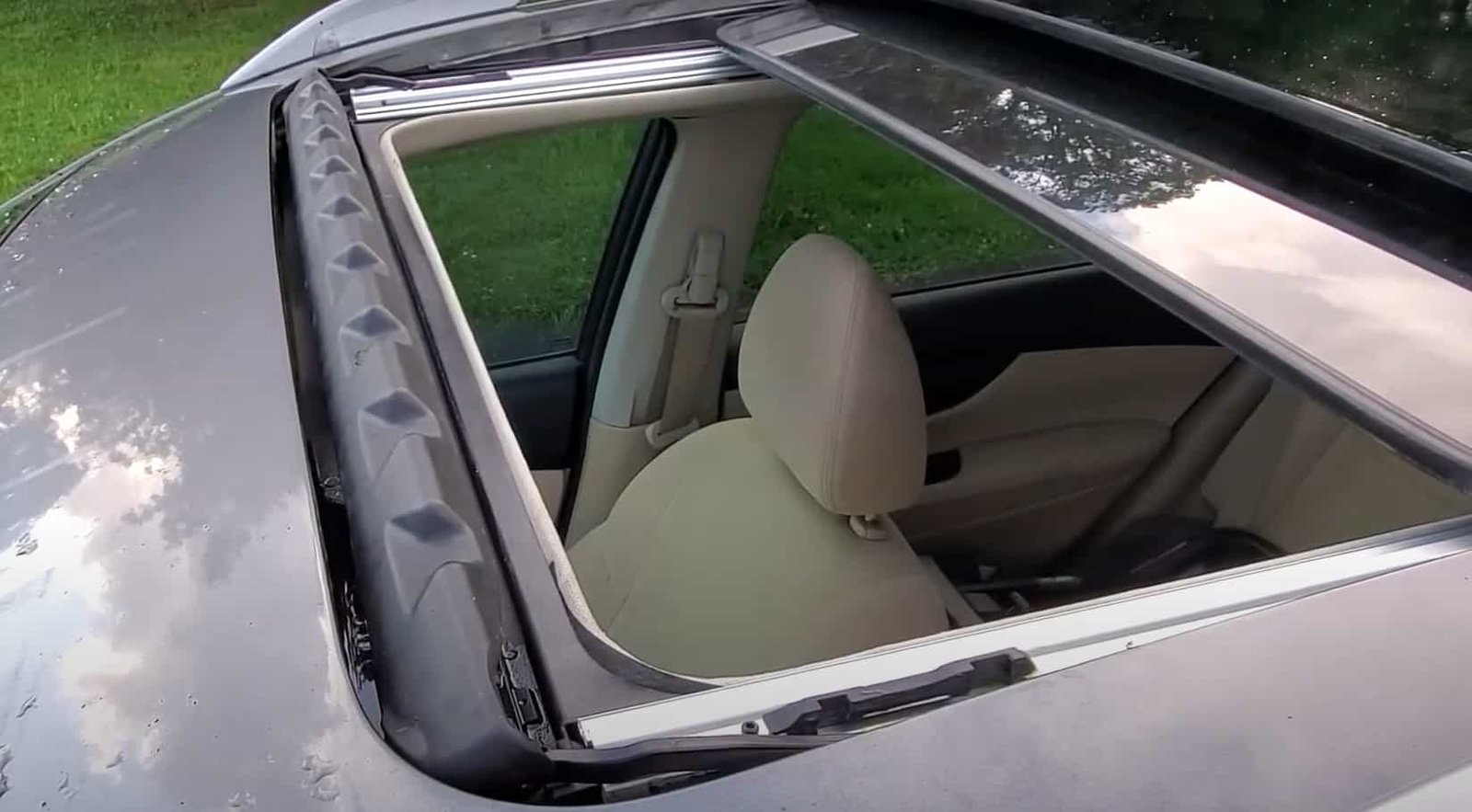A small Nissan Rogue sunroof leak might seem harmless at first, but it can quickly turn into an expensive nightmare. What starts as a few drops of water can lead to soaked carpets, moldy interiors, and even electrical system failures if left untreated. Many Rogue owners have reported mysterious damp spots after heavy rain, often discovering that the sunroof drainage system or its seals were to blame.
The truth is, the Nissan Rogue-especially models from 2014 to 2021-has a design that makes it vulnerable to drainage blockages and worn rubber seals over time. Yet, most drivers overlook these small signs until water damage becomes severe.
In this guide, we’ll uncover the top five causes of Nissan Rogue sunroof leaks that every owner should know. From clogged drains to cracked frames, understanding these issues early can help you save hundreds of dollars in repair costs and protect your vehicle’s resale value. Don’t ignore the warning signs-your sunroof might be telling you something important.
Clogged Sunroof Drains – The Hidden Trigger Behind Most Leaks
One of the most common reasons behind a Nissan Rogue sunroof leak is a clogged drainage system. Every Rogue is equipped with four drain tubes-one at each corner of the sunroof-that are designed to carry rainwater safely down and out through the fenders. Over time, these drains can become blocked with dust, pollen, or fallen leaves, causing water to overflow back into the cabin.
You might first notice damp floor mats, a musty smell, or water dripping from the A-pillars after a heavy rain. Many owners mistake this for a windshield issue, but in reality, the sunroof drain tubes are the real culprits.
To check, open your sunroof and gently pour a small cup of water into each corner. If the water doesn’t drain out under the car within seconds, your drains are likely clogged. A quick fix is to use compressed air or a flexible wire to clear the blockage-but be careful not to puncture the tubing.
Ignoring this simple maintenance step can lead to soaked insulation, mold buildup, and even corrosion of electronic components under the floorboard. Keeping your sunroof drains clean at least twice a year is one of the easiest ways to prevent water leaks and protect your Nissan Rogue’s interior.
Damaged or Worn Rubber Seals – When Time and Heat Take Their Toll
Another frequent cause of a Nissan Rogue sunroof leak comes from deteriorating rubber seals. These seals line the perimeter of the sunroof and act as a watertight barrier between the glass and the roof frame. Over time, exposure to direct sunlight, extreme heat, and temperature fluctuations causes the rubber to harden, crack, or lose its elasticity. Once that happens, even a light drizzle can sneak through the gaps and drip directly into your cabin.
You may notice faint water streaks along the edges of the glass, or hear a faint whistling sound at highway speeds – both are early signs that your sunroof seals are no longer doing their job. The longer these seals remain damaged, the greater the chance of water seeping into your headliner or electrical modules hidden in the roof.
To fix the problem, clean the seals regularly with a soft microfiber cloth and apply a silicone-based rubber conditioner every few months. This helps keep them supple and prevents cracking. If the seals are visibly worn or detached, replacing them is the only long-term solution.
A new set of OEM sunroof seals for the Nissan Rogue typically costs between $80 and $150, excluding labor. It’s a small investment compared to the hundreds you might spend on water damage repairs later. Preventive care here truly pays off.
Improper Sunroof Alignment or Installation Error – A Hidden Manufacturing or Repair Flaw
Even if your Nissan Rogue sunroof looks perfectly fine from the outside, an incorrect alignment can still lead to persistent leaks. This issue often appears after a windshield replacement, roof repair, or accident that slightly shifts the sunroof frame out of position. When the glass panel doesn’t sit evenly against the rubber seals, small gaps can form-allowing rainwater to bypass the drainage system and trickle directly into the cabin.
Owners who experience this type of sunroof leak often report hearing wind noise or noticing water pooling around the front corners of the sunroof after driving in heavy rain. Because these gaps are so small, they’re nearly invisible without a close inspection.
To test alignment, open and close your sunroof slowly while observing whether it sits flush with the roof surface. If you notice uneven spacing or resistance during movement, it’s likely misaligned. Unfortunately, this is not a DIY fix-realignment requires precision tools and should be done by a certified technician familiar with Nissan’s sunroof assembly specifications.
A properly aligned sunroof not only prevents leaks but also extends the life of your seals and tracks. Spending a little on professional adjustment now can save you from replacing the entire sunroof assembly later-a repair that can easily exceed $1,000.
Blocked Sunroof Drain Outlets Near the Fender Area – When the Problem Moves Downstream
Sometimes, the issue behind a Nissan Rogue sunroof leak isn’t at the sunroof itself but farther down the drainage system. The Rogue’s sunroof drain tubes run from the roof corners down through the A-pillars and exit near the fender area or behind the wheel wells. Over time, these drain outlets can become clogged with dirt, leaves, or even small insects-especially if you frequently park under trees. When the outlet is blocked, water has nowhere to go and eventually backs up into the cabin.
This type of leak can be deceptive. You might find wet carpeting near the front footwells or a puddle under the dashboard without any visible leak from the sunroof frame. In reality, water is overflowing from the bottom of the drain tubes and entering through hidden gaps behind interior panels.
To inspect this area, locate the outlet under your car (usually behind the front fender liner) and use compressed air or a thin plastic probe to clear the passage. Avoid using metal wires-they can puncture the rubber tubing. After cleaning, pour a small amount of water into the sunroof tray to ensure it flows freely from the outlet.
Routine inspection of these outlets every few months, especially after fall or heavy rain seasons, can prevent major water intrusion issues and extend the lifespan of your Nissan Rogue’s drainage system.
Cracked Sunroof Frame or Glass Bond Failure – The Most Costly Culprit
While less common, a cracked sunroof frame or failed glass bonding can be one of the most serious causes of a Nissan Rogue sunroof leak. The sunroof assembly relies on a strong adhesive bond between the glass panel and its metal frame to remain watertight. Over time, exposure to heat, vibration, and repeated opening and closing can weaken this bond. Once the seal between the glass and frame starts to separate, water can easily seep through-often bypassing the drainage system entirely.
You may notice water dripping directly from the sunroof glass itself, or visible cracks forming along the edges. Some owners report hearing creaking sounds when driving over bumps, which can indicate that the frame is beginning to warp. Unfortunately, this type of leak can quickly damage the vehicle’s headliner, airbags, and electrical wiring if left unaddressed.
Repairing or resealing a cracked sunroof frame typically requires professional service. Depending on the severity, you may need to replace the entire sunroof assembly, which can cost anywhere from $800 to $1,500, including labor.
If you suspect this issue, avoid using the sunroof until inspected. Preventive maintenance-like gentle operation and periodic cleaning of the track-can help reduce stress on the glass and frame over time, minimizing the risk of future leaks.
Conclusion
A Nissan Rogue sunroof leak might start as a minor inconvenience, but as you’ve seen, it can be caused by several hidden issues-from clogged drains to cracked frames. Each of these problems can quietly lead to interior damage, electrical malfunctions, or costly repairs if ignored. Regular inspection and preventive maintenance are the keys to keeping your sunroof watertight and your cabin dry.
If you’ve noticed musty odors, damp carpets, or water stains on the headliner, don’t wait until the next storm to act. Check your drains, clean your seals, and have a technician inspect the alignment if needed. Spending a few minutes on maintenance now can save you from hundreds of dollars in repairs later.
The Nissan Rogue is a reliable SUV, but like any vehicle, it demands attention to detail-especially when it comes to something as overlooked as the sunroof. By understanding the top five causes of Nissan Rogue sunroof leaks, you can protect your investment, avoid unnecessary headaches, and enjoy a safer, more comfortable drive.
Have you experienced a sunroof leak in your Nissan Rogue? Share your story or fix in the comments below-your insight could help another owner keep their vehicle leak-free.

